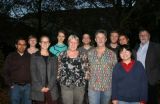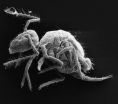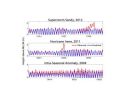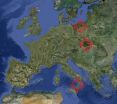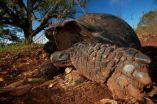(Press-News.org) Malaria is a life-threatening disease that strikes more than 200 million people every year – mainly in Africa, Asia and Latin America. The disease is caused by the Plasmodium parasite, which is spread by infected mosquito bites. Today, malaria can be prevented and successfully treated, but more than half a million people nevertheless die every year from the disease.
Large-scale monitoring and treatment programmes during the past decade have reduced the distribution of the disease, and the frequency of actual epidemics has fallen. However, the number of malaria patients with relatively low infection counts has increased, and the need for more sensitive methods to diagnose the disease has thus increased dramatically.
Development of new, simple and sensitive method
To meet this need, researchers at Aarhus University have developed a new method that can diagnose malaria infections with very high sensitivity. The method is based on measuring the activity of an enzyme called topoisomerase I from the Plasmodium parasite.
The researchers have developed a technology called REEAD (Rolling Circle-Enhanced Enzyme Activity Detection) – which makes it possible to diagnose malaria from a single drop of blood or saliva. This method is much more time-effective and cost-effective than current diagnostic methods, and can be performed by personnel who have no specialised training. It can therefore be used in low-resource areas without the use of expensive equipment, clean water or electricity.
The ongoing fight against malaria is complicated by increasing problems with resistant Plasmodium parasites. In addition, several Plasmodium species (P. vivax and P. knowlesi) cannot be detected with the usual quick-test methods.
The new REEAD-based method distinguishes itself from other quick-test methods because it can measure whether a given Plasmodium infection is resistant to drugs. The newly developed technology is also the only quick-test method that makes it possible to diagnose the less common malaria parasites (P. ovale, P. knowlesi and P. malariae) in addition to the most common Plasmodium parasites (P. falciparum and P. vivax).
The unique sensitivity, combined with its ability to detect infection in very small samples of blood or saliva, makes the method suitable for large-scale screening projects. This is of great importance in areas where the disease is close to being eradicated, and where it is therefore essential to identify and treat all patients infected with one of the above-mentioned parasites – even those who do not show symptoms of the disease.
Interdisciplinary, international collaboration
"This combination of molecular biologists, doctors, engineers and statisticians has been important for our success in developing the new method," says Associate Professor Birgitta Knudsen, who is the driving force behind the project.
INFORMATION:
In addition to her group, which is affiliated with the Interdisciplinary Nanoscience Centre (iNANO) and the Department of Molecular Biology and Genetics, Aarhus University, researchers from both Denmark (Department of Pathology and Department of Clinical Medicine, Aarhus University Hospital) and abroad (Duke University, University of Rome, University of St Andrews and University of Lyon) contributed to this project.
New method for diagnosing malaria
2012-11-27
ELSE PRESS RELEASES FROM THIS DATE:
A rather thin and long new snake crawls out of one of Earth's biodiversity hotspots
2012-11-27
Field and laboratory work by a group of zoologists led by Omar Torres-Carvajal from Museo de Zoología QCAZ, Pontificia Universidad Católica del Ecuador, has resulted in the discovery of a new species of blunt-headed vine snake from the Chocoan forests in northwestern Ecuador. This region is part of the 274,597 km2 Tumbes-Chocó-Magdalena hotspot that lies west of the Andes. The study was published in the open access journal ZooKeys.
Blunt-headed vine snakes live in an area comprising Mexico and Argentina, and are different from all other New World snakes in having a very ...
Three new arthropod species have been found in the Maestrazgo Caves in Teruel
2012-11-27
A team of scientists from the University of Navarra and the Catalan Association of Biospeleology have discovered three new collembolan species in the Maestrazgo caves in Teruel, Spain. Their description has been published in the Zootaxa journal. These minute animals belong to one of the most ancient animal species on the planet.
The Maestrazgo caves in Teruel are located in a region of the Iberian Range where fauna has not been the subject of much study. It is a very isolated region since its average altitude is between 1,550 m and 2,000 m asl and its climate can be described ...
New test to help heavy drinkers reduce alcohol intake
2012-11-27
Researchers at the University of Liverpool have developed a computer-based test that could help heavy drinkers reduce their alcohol consumption.
Regular heavy drinking can lead to serious health conditions such as liver and heart disease, costing the NHS millions of pounds every year. Research at Liverpool has shown that the habit of consuming alcohol can be interrupted when people practice methods of restraint whenever they see images of alcoholic drinks.
The team developed a computer test that required participants to press particular buttons when an image of alcohol ...
Paralysis by analysis should not delay decisions on climate change
2012-11-27
Uncertainty about how much the climate is changing is not a reason to delay preparing for the harmful impacts of climate change says Professor Jim Hall of the Environmental Change Institute at the University of Oxford and colleagues at the Tyndall Centre for Climate Change Research, writing today in Nature Climate Change.
The costs of adapting to climate change, sea-level and flooding include the upfront expenses of upgrading infrastructure, installing early-warning systems, and effective organisations, as well as the costs of reducing risk, such as not building on flood ...
Researcher studies 'middle ground' of sea-level change
2012-11-27
The effects of storm surge and sea-level rise have become topics of everyday conversation in the days and weeks following Hurricane Sandy's catastrophic landfall along the mid-Atlantic coast.
Ongoing research by professor John Brubaker of the Virginia Institute of Marine Science is throwing light on another, less-familiar component of sea-level variability—the "intra-seasonal" changes that occupy the middle ground between rapid, storm-related surges in sea level and the long-term increase in sea level due to global climate change.
"These are cases when the water is ...
From Mediterranean coasts to Tatra Mountains and beyond: Plant chromosome number variation
2012-11-27
Chromosome number is the most basic feature concerning the genome of a species, and it is known for about one third of higher plant species. In particular, for plants of Italy, Slovakia, and Poland, online chromosome number databases have been developed: 'Chrobase.it – Chromosome numbers for the Italian flora', 'Karyological database of ferns and flowering plants of Slovakia' and 'Chromosome number database – PLANTS', respectively. The three datasets account for about 35%, 60% and 40% of the whole floras, respectively.
"We used these datasets to compare chromosome number ...
Researchers explore social media as preventative method for infectious diseases
2012-11-27
MANHATTAN, Kan. -- When it comes to stopping illness, social media posts and tweets may be just what the doctor ordered.
A Kansas State University-led research team is looking at social media as a tool to reduce and prevent diseases from spreading. Researchers are studying whether a well-timed post from a public authority or trustworthy person could be as beneficial as flu shots, hand-washing or sneezing into an elbow.
"Infectious diseases are a serious problem and historically have been a major cause of death," said Faryad Sahneh, Kansas State University doctoral candidate ...
Man's best friend: Common canine virus may lead to new vaccines for deadly human diseases
2012-11-27
Athens, Ga. – Researchers at the University of Georgia have discovered that a virus commonly found in dogs may serve as the foundation for the next great breakthrough in human vaccine development.
Although harmless in humans, parainfluenza virus 5, or PIV5, is thought to contribute to upper respiratory infections in dogs, and it is a common target for canine vaccines designed to prevent kennel cough. In a paper published recently in PLOS ONE, researchers describe how this virus could be used in humans to protect against diseases that have eluded vaccine efforts for decades.
"We ...
Galapagos tortoises are a migrating species
2012-11-27
This press release is available in German.
The Galapagos giant tortoise, one of the most fascinating species of the Galapagos archipelago, treks slowly and untiringly across the volcanic slopes. Scientists of the Max Planck Institute for Ornithology in Radolfzell, together with the Charles Darwin Foundation, have used GPS technology and modern 3D acceleration measurements to find out that especially the dominant male tortoise wanders up to 10 kilometres into the highlands of the island. Only the fully grown animals migrate, the young tortoises stay year round in ...
Do missing Jupiters mean massive comet belts?
2012-11-27
Using ESA's Herschel space observatory, astronomers have discovered vast comet belts surrounding two nearby planetary systems known to host only Earth-to-Neptune-mass worlds. The comet reservoirs could have delivered life-giving oceans to the innermost planets.
In a previous Herschel study, scientists found that the dusty belt surrounding nearby star Fomalhaut must be maintained by collisions between comets.
In the new Herschel study, two more nearby planetary systems – GJ 581 and 61 Vir – have been found to host vast amounts of cometary debris.
Herschel detected ...
